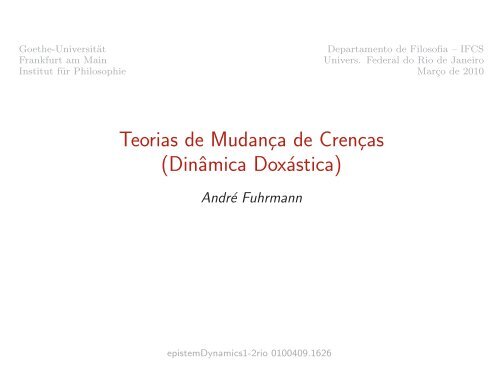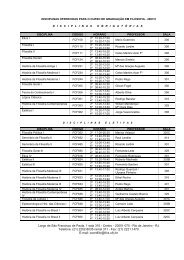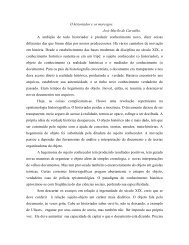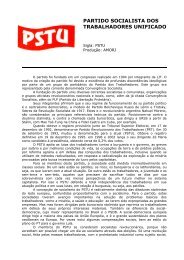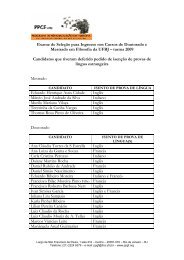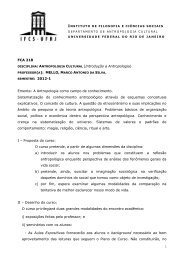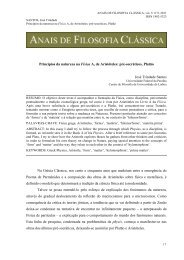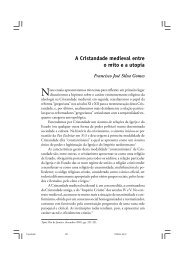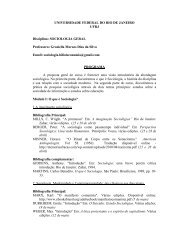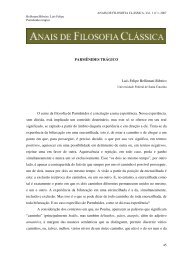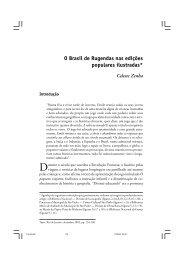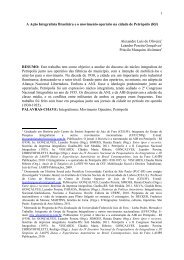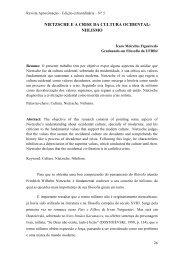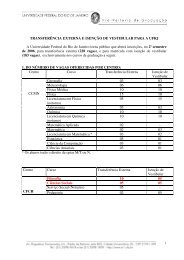Teorias de Mudança de Crenças (Dinâmica Doxástica) - IFCS
Teorias de Mudança de Crenças (Dinâmica Doxástica) - IFCS
Teorias de Mudança de Crenças (Dinâmica Doxástica) - IFCS
Create successful ePaper yourself
Turn your PDF publications into a flip-book with our unique Google optimized e-Paper software.
Goethe-Universität<br />
Frankfurt am Main<br />
Institut für Philosophie<br />
<strong>Teorias</strong> <strong>de</strong> <strong>Mudança</strong> <strong>de</strong> <strong>Crenças</strong><br />
(<strong>Dinâmica</strong> <strong>Doxástica</strong>)<br />
André Fuhrmann<br />
epistemDynamics1-2rio 0100409.1626<br />
Departamento <strong>de</strong> Filosofia – <strong>IFCS</strong><br />
Univers. Fe<strong>de</strong>ral do Rio <strong>de</strong> Janeiro<br />
Março <strong>de</strong> 2010
Esta série <strong>de</strong> oito palestras foi realizada entre os dias 3 e 29 <strong>de</strong> Março <strong>de</strong> 2010 no<br />
programa <strong>de</strong> Pós-Graduação em Filosofia no <strong>IFCS</strong> da Universida<strong>de</strong> Fe<strong>de</strong>ral do Rio <strong>de</strong><br />
Janeiro. Gostaria <strong>de</strong> agra<strong>de</strong>cer aos meus anfitriões, Profs. Wilson Mendonça e Maria<br />
Clara Dias, e aos meus alunos no Rio, em particular Idia L. Ferreira e Julia Telles. Fico<br />
também grato pelo apoio financeiro recebido pelo CAPES e o DAAD.<br />
As palestras baseiam-se numa contribuição ao Routledge Companion to Epistemology,<br />
org. por Sven Bernecker and David Pritchard, a ser publicado em 2010.<br />
André Fuhrmann<br />
Rio <strong>de</strong> Janeiro<br />
Abril <strong>de</strong> 2010<br />
2
Justificação epistêmica<br />
· Justificação sincrônica e diacrônica<br />
Conteúdo<br />
· O problema chave <strong>de</strong> justificação diacrônica<br />
Teoria clássica <strong>de</strong> AGM<br />
· A teoria clássica da dinâmica <strong>Doxástica</strong> <strong>de</strong> AGM<br />
· Postulados para contrações e revisões<br />
· O Teste do Ramsey para condicionais contrafatuais<br />
· Contrações por intersecção<br />
· Sistemas <strong>de</strong> esferas<br />
AGM como lógica modal<br />
3<br />
· AGM e Elementary Propositional Dynamic Logic (EPDL)<br />
· Lógica <strong>Dinâmica</strong> <strong>Doxástica</strong> (DDL)<br />
· Extensions of DDL to a Dynamic Epistemic Logic (DEL) (em Inglês)<br />
Conteúdo
Justificação epistêmica<br />
Justificação epistêmica<br />
Clara vê o Peter dirigindo um Maserati preto em Frankfurt.<br />
Ela crê que se o Peter dirige um carro em Frankfurt (cida<strong>de</strong> <strong>de</strong>le, vamos supor), então<br />
ele é dono daquele carro.<br />
Em consequência, Clara crê (ao tempo t) que<br />
(m) Peter é dono <strong>de</strong> um Maserati preto.<br />
4
Um problema tradicional<br />
Seja K o conjunto das crenças <strong>de</strong> Clara no tempo t.<br />
• As crenças em K estão justificadas?<br />
• Em particular, será que a crença (m) está justificada?<br />
A crença (m) <strong>de</strong>pen<strong>de</strong> (<strong>de</strong>ductivamente) nas seguintes crenças:<br />
(a) Foi o Peter quem dirigiu o carro que a Clara viu em Frankfurt.<br />
(b) O carro era um Maserati preto.<br />
(c) Se Peter dirige um carro em Frankfurt, então é o carro <strong>de</strong>le.<br />
a b c [= a ∧ b → m]<br />
m<br />
• Problema: Será que as crenças (a-c) estão justificadas?<br />
(O problema <strong>de</strong> justificar as crenças atuais <strong>de</strong> uma pessoa)<br />
5<br />
↩→ <strong>Teorias</strong> tradicionais <strong>de</strong> justificação epistêmica.<br />
Justificação epistêmica
Um problema distinto<br />
Justificação epistêmica<br />
Clara <strong>de</strong> repente soube <strong>de</strong> uma fonte confiável que o Pedro não é dono <strong>de</strong> um Maserati,<br />
i.e. ¬m. Sendo assim, ela <strong>de</strong>ci<strong>de</strong> dispensar da sua crença em m (talvez para aceitar<br />
¬m em seguida).<br />
• Tarefa: Proce<strong>de</strong> <strong>de</strong> K para K-sem-m!<br />
Mas a presença <strong>de</strong> m é <strong>de</strong>ductivamente forcada pelas outras crenças da Clara: a, b e c.<br />
• Segue-se: Clara <strong>de</strong>ve cancelar pelo menos uma das suas crenças a, b ou c. Naturalmente<br />
ao fim <strong>de</strong> cancelar o comprometimento com m, ela po<strong>de</strong> <strong>de</strong>sativar muitas<br />
outras crenças além <strong>de</strong> a, b ou c – Clara po<strong>de</strong>ria até cai em meditações cartesianas.<br />
K − m = {· · · a, b · · ·} ? {· · · a, c · · ·} ? {· · · b, c · · ·} ?<br />
= {· · · a · · ·} ? {· · · b · · ·} ? {· · · c · · ·} ? {· · ·} ? {cogito}??<br />
• Problema: Dada uma <strong>de</strong>cisão <strong>de</strong> cancelar m, qual conjunto <strong>de</strong> crenças K −m qualifica<br />
como o legítimo (justificado!) succedor to K?<br />
(O problema <strong>de</strong> justificar mudanças <strong>de</strong> crenças.)<br />
6<br />
↩→ <strong>Teorias</strong> “dinámicas” <strong>de</strong> justificação epistêmica.
Taking a closer look at the two problems<br />
[Po<strong>de</strong>-se pular para folha 16: “Voltando ao problema”.]<br />
Justificação epistêmica<br />
The problem of static justification consists in filling the blank in the scheme<br />
(S) x R K.<br />
where R respresents some suitable relation of justification.<br />
The object of justification, K, is an epistemic state, a belief set. Candidates for the<br />
justifier x are well known, e.g.:<br />
7<br />
· fundamental beliefs<br />
(i.e. a distinguished subset of K),<br />
· coherence<br />
(i.e. the obtaining of certain relations within K),<br />
· reliable causal anchoring<br />
(i.e. the obtaining of certain relation between K and the world).
In the dynamical case the problem concerns a different schema, viz.<br />
(D) x R (K, K ′ ).<br />
Justificação epistêmica<br />
The object of justification is now a pair of epistemic states (representing the transition<br />
from one belief state, K, to another one, K).<br />
Question:<br />
Can we reduce the dynamic case to the static one or vice versa?<br />
Perhaps ...<br />
8
Can we reduce the dynamic case (D) to the static one (S)?<br />
1. (K, K ′ ) is D-justified iff K ′ is S-justified.<br />
Justificação epistêmica<br />
But the origin state K does not enter the right-hand-si<strong>de</strong>. Thus follow some rather<br />
implausible claims:<br />
• (→) The existence of an origin K such that the transition from K to K ′ would be<br />
D-justified, suffices for K ′ to be S-justified.<br />
· Let K = K. The trivial transition (K, K) is presumably always D-justified. But<br />
then every belief set K would be S-justified. – Not a good i<strong>de</strong>a.<br />
• (←) All transitions (K, K ′ ) would be D-justified, given only that K ′ is S-justified.<br />
9<br />
· In effect this <strong>de</strong>nies that there is any interesting notion of justifying belief changes.<br />
All belief changes are equally good as long as they are changes to S-justified states.<br />
– Radical and implausible as long as more discriminatory theories of belief change<br />
remain possible.
Can we reduce the dynamic case (D) to the static one (S)?<br />
Justificação epistêmica<br />
2. (K, K ′ ) is D-justified iff the successor state K ′ is justified a time t ′ when the<br />
transition is ma<strong>de</strong> from K which was S-justified at some prior time t.<br />
• (→) The transition (K, K ′ ) may be D-justified without K ever having been S-justified.<br />
In effect the proposal makes it impossible to ever leave behing a D-unjustifiable belief<br />
state. – Not a good i<strong>de</strong>a.<br />
• (→) We may want to allow for the following possibility: The transition (K, K ′ ) may<br />
be D-justified without K ′ being S-justified. Perhaps K ′ is only slightly better than<br />
K but not sufficiently better to be called S-justified.<br />
10
Can we reduce the dynamic case (D) to the static one (S)?<br />
3. (K, K ′ ) is D-justified iff K ′ is better S-justified than K.<br />
Justificação epistêmica<br />
• (→) Good transition to bad beliefs: The transition could be a D-good one – required<br />
un<strong>de</strong>r the circumstances – without K ′ being S-better than K.<br />
· K ′ result from K by adding some contingent information. Some such additions<br />
must be D-justfiable so let us assume that (K, K ′ ) is. But K ′ is riskier than K.<br />
Thus, if we assume that the <strong>de</strong>gree of S-justification <strong>de</strong>creases as the risk of error<br />
increases, then K ′ is less S-justified than K.<br />
• (←) Bad transition to better beliefs: K ′ could be S-better than K but there is no<br />
way of getting from K to K ′ in a D-justified manner.<br />
11<br />
· Let A ∈ K be a well-(S-)justified belief. Let K ′ contain only those beliefs that are<br />
at least as S-justified as A. The K ′ is certainly S-better than K. But the transition<br />
(K, K ′ ) involves a gratuitous loss of information and is therefore not D-justified.
Can we reduce the static case to the dynamic one?<br />
The Cartesian mo<strong>de</strong>l:<br />
Justificação epistêmica<br />
• A belief state is S-justified iff<br />
the state may be presented as the final point of a series of D-justified transitions<br />
taking its origin in the urkorpus (Levi) – cogito (Descartes).<br />
Perhaps ...<br />
12
A strong thesis (Isaac Levi)<br />
◦ Inquiry is the process by which we “fix” (Peirce) and change our beliefs.<br />
◦ Beliefs are <strong>de</strong>termined by their rôle in inquiry.<br />
Justificação epistêmica<br />
• For a belief to play its rôle in inquiry, the agent has to accept his beliefs. To accept<br />
a belief is to accept the belief as true.<br />
• As long as an agent accepts a belief he cannot seriously doubt that belief.<br />
• As long as an agent does not seriously doubt a belief, he cannot seriously ask whether<br />
that belief is justified.<br />
• Hence, in the course of inquiry an agent presupposes that his current beliefs are<br />
infallible.<br />
• From the agent’s point of view the attempt to justify his current beliefs is incoherent.<br />
• (This does not rule out that the agent may want to persua<strong>de</strong> other agents of his<br />
belief by offering ”justifying” reasons to adopt that belief. But this is not an attempt<br />
at justifying one’s beliefs but an attempt to get others to perform a justified belief<br />
change.)<br />
13
◦ Inquiry presupposes that beliefs are corrigible.<br />
Justificação epistêmica<br />
• Giving up (“correct”) a belief that the agent at some point must take to be infallible<br />
needs justification.<br />
• Thus, from the viewpoint of the agent, justifying one’s current beliefs is incoherent<br />
while passing from one belief state to another does need justification.<br />
The strong thesis:<br />
Static epistemic justification is a bogus problem, while dynamic epistemic<br />
justification is not.<br />
[Isaac Levi: The Enterprise of Knowledge (1980), Decisions and Revisions (1984).]<br />
Whatever one may think of the strong thesis, it is astonishing<br />
14<br />
· that the static problem of justification has been taken to <strong>de</strong>fine the enterprise of<br />
epistemology for <strong>de</strong>ca<strong>de</strong>s, and it is even more astonishing<br />
· that the distinct problem of dynamic justification has generally gone unnoticed<br />
(until ca 1985 and with a few exceptions).
A possible explanation:<br />
Justificação epistêmica<br />
Thomas Kuhn (The Structure of Scientific Revolutions, 1970) has presented a theory<br />
of belief changes (theory changes). According to that theory large scale belief changes<br />
– paradigm shifts – do not bow to rational control. (Though Kuhn also asserted that<br />
changes within a paradigm are largely governed by the methodological rules of that<br />
paradigm.)<br />
• Kuhn’s theory (sufficiently vulgarized) has enforced for <strong>de</strong>ca<strong>de</strong>s relativistic ten<strong>de</strong>ncies<br />
in philosophy and – even more so – in neighbouring disciplines. Such ten<strong>de</strong>ncies are<br />
rarely shared by epistemologists.<br />
· Belief changes, on the one hand, appeared un<strong>de</strong>r the Kuhnian perspective as rationally<br />
impredictable and not subject to normative contraints.<br />
· Most epistemologists agreed that knowledge claims, on the other hand and to the<br />
contrary, are subject to rational assessment.<br />
• Consequence: The static problem remained within traditional epistemology; the dynamic<br />
problem – together with its relativistic si<strong>de</strong> effects – was exiled to the History<br />
of Science.<br />
15
Abordagem da forma mais simples:<br />
• Conjunto <strong>de</strong> crenças.<br />
• Informação nova.<br />
Voltando ao problema<br />
• Decisão (<strong>de</strong>spertada pela informação) <strong>de</strong> aceitar uma nova crença.<br />
• Como proce<strong>de</strong>r?<br />
16<br />
A!<br />
K K mit A<br />
Voltando ao problema
Uma abordagem abstrata: três casos, três operações<br />
Estado original K; transição para K ′ .<br />
Três casos, três operações:<br />
• K ⊂ K ′ : K ′ resulta por uma expansão <strong>de</strong> K.<br />
• K ⊃ K ′ : K ′ resulta por uma contração <strong>de</strong> K.<br />
• Nem ⊂ nem ⊃: K ′ resulta por uma revisão <strong>de</strong> K.<br />
17<br />
Voltando ao problema
Uma abordagem mais concreta: Dois caso, três operações<br />
Estado original K; informação nova A!<br />
• Primeiro caso: A compatível (= consistente) com K.<br />
Simples: Vamos expandir K por A para obter K + A.<br />
• Segundo caso: A inconsistente com K, i.e. ¬A ∈ K.<br />
Difícil: Temos que revisar K para incluir A, chegando a K ∗ A.<br />
Voltando ao problema<br />
· Observação quanto ao caso segundo: Primeiro precisa fazer K consistente com<br />
A por tirar ¬A <strong>de</strong> K, assim chegando à contração K − ¬A. A seguir só precisa<br />
expandir o resultado por A. Somamos os dois passos na<br />
I<strong>de</strong>ntidate do Levi:<br />
• Assim temos três operações:<br />
18<br />
· Expansão: K + A<br />
· Contração: K − A<br />
· Revisão: K ∗ A<br />
K ∗ A = (K − ¬A) + A
Programa<br />
Problema inicial:<br />
O que são mudanças racionais (“boas”) <strong>de</strong> crenças?<br />
Voltando ao problema<br />
Tese:<br />
Todas as mudanças boas <strong>de</strong> crenças po<strong>de</strong>m ser apresentadas como (<strong>de</strong>compostas em)<br />
sequências <strong>de</strong> boas expansões, contrações ou revisões.<br />
Tarefa(s):<br />
Resolver o problema inicial por buscar uma teoria <strong>de</strong> boas expansões, contrações e<br />
revisões.<br />
Sneak preview:<br />
Veremos que<br />
· o problema das expansões tem uma solução fácil, e<br />
· revisões po<strong>de</strong>m ser <strong>de</strong>finidos em termos <strong>de</strong> contrações e expansões (Id. do Levi!).<br />
Assim as tarefas reduzem-se a fornecer uma teoria das boas contrações.<br />
19
Sistemas <strong>de</strong> crença/Estados epistémicos/<strong>Teorias</strong><br />
• Linguagem da lógica proposicional:<br />
• Obrigações lógicas.<br />
• Fechamento lógico:<br />
20<br />
P, Q, ..., ¬, ∧, ∨ →, ...<br />
A, B, C, ...<br />
K = Cn(K)<br />
Voltando ao problema
• Operação <strong>de</strong> fechamento lógico: Cn<br />
Forma relacional:<br />
X ⊆ Cn(X);<br />
se X ⊆ Y , então Cn(X) ⊆ Cn(Y );<br />
Cn(Cn(X)) = Cn(X);<br />
se A ∈ Cn(X), então ∃X ′ ⊆ X : X ′ é finito e A ∈ Cn(X ′ ).<br />
Voltando ao problema<br />
X ⊢ A em vez <strong>de</strong> A ∈ Cn(X) e A ≡ B em vez <strong>de</strong> Cn(A) = Cn(B).<br />
• Fechamento <strong>de</strong> forma relacional:<br />
21<br />
A ∈ K sse K ⊢ A.
Expansões<br />
Case K é compatível (consistente) com A, i.e.<br />
⇒<br />
Simples!<br />
22<br />
¬A /∈ K<br />
K + A := Cn(K ∪ {A})<br />
Voltando ao problema
(m) Pedro é dono <strong>de</strong> um Maserati.<br />
Revisões e contrações<br />
a b a ∧ b → m<br />
· Escolha: Não somente um problema lógico!<br />
• Núcleo da teoria: i<strong>de</strong>ntificar as opções e fazer uma escolha racional.<br />
“cognitive <strong>de</strong>cision theory” (Levi) – teoria <strong>de</strong> escolha cognitiva.<br />
23<br />
m<br />
Voltando ao problema
AGM: Postulados e construções<br />
As fontes da teoria <strong>de</strong> AGM<br />
Inquiry como uma teoria <strong>de</strong> escolha cognitiva:<br />
Isaac Levi (1967ff.)<br />
24<br />
AGM: Postulados e construções
Semântica epistêmica das proposições condicionais:<br />
Peter Gär<strong>de</strong>nfors (1978ff.)<br />
AGM: Postulados e construções<br />
If two people are arguing ‘If p will q?’ and are both in doubt as to p, they are adding<br />
p hypothetically to their stock of knowledge and arguing on that basis about q.<br />
(Frank P. Ramsey, General propositions and causality, 1929)<br />
25
Derogação <strong>de</strong> normas jurídicas:<br />
Carlos Alchourrón e David Makinson (1981ff.)<br />
AGM: Postulados e construções<br />
Suppose that A is a set of regulations, y is some proposition that is implied by A, and<br />
that for some reason a legislative body wants to eliminate y. In such a situation, the<br />
body may <strong>de</strong>ci<strong>de</strong> to reject y, with the intention of thereby rejecting implicitly whatever<br />
in A implies y, retaining the remain<strong>de</strong>r. This we shall call <strong>de</strong>rogation.<br />
(AM, Hierarchies of regulations and their logic, 1981)<br />
26
Consi<strong>de</strong>rações pré-teóricas<br />
Juntar informaçao interessante/valorosa e confiável:<br />
◦ quanto mais interessante tanto mais ariscada,<br />
◦ quanto mais confiável tanto menos interessante.<br />
· Cn(∅): o estado mais confiável e o menos interessante!<br />
• Equilíbrio razoável.<br />
• −/ ∗ /+: teorias ↦→ teorias<br />
AGM: Postulados e construções<br />
• A origem já está num equilíbrio: Não abre mão <strong>de</strong> informação sem necessida<strong>de</strong><br />
(Quine: Máxima <strong>de</strong> Mutilação Mínima)!<br />
27
• Postulados/condições<br />
• Construções<br />
• Harmonia: resultados <strong>de</strong>s representação<br />
· construções satisfazem as condições, e<br />
Estratégia<br />
· operações que satisfazem os condições po<strong>de</strong>m ser tal construidos.<br />
• Estabilida<strong>de</strong> da teoria<br />
28<br />
AGM: Postulados e construções
(C1) Closure<br />
(C2) Success<br />
(C3) Inclusion<br />
(C4) Vacuity<br />
(C5) Recovery<br />
(C6) Congruence<br />
(C7) Conjunction 1<br />
(C8) Conjunction 2<br />
29<br />
Postulados <strong>de</strong> AGM para contrações<br />
K − A = Cn(K − A) (F echamento)<br />
A /∈ K − A, se ⊢ A<br />
K − A ⊆ K<br />
Se A /∈ K, então K − A = K<br />
K ⊆ (K − A) + A (resgate)<br />
Se A ≡ B, então K − A = K − B<br />
Suplementários<br />
K − A ∩ K − B ⊆ K − (A ∧ B)<br />
Se A /∈ K − (A ∧ B), então K − (A ∧ B) ⊆ K − A<br />
AGM: Postulados e construções
(R1) Closure<br />
(R2) Success<br />
(R3) Inclusion<br />
(R4) Preservation<br />
(R5) Consistency<br />
(R6) Congruence<br />
(R7) Conjunction 1<br />
(R8) Conjunction 2<br />
[BDD-Axiome]<br />
30<br />
Postulados <strong>de</strong> AGM para revisões<br />
K ∗ A = Cn(K ∗ A)<br />
A ∈ K ∗ A<br />
K ∗ A ⊆ K + A<br />
Se ¬A /∈ K, então K ∗ A = K + A<br />
Se ⊥ ∈ K ∗ A, então ⊢ ¬A<br />
Se A ≡ B, então K ∗ A = K ∗ B<br />
Suplementários<br />
K ∗ (A ∧ B) ⊆ (K ∗ A) + B<br />
Se ¬B /∈ K ∗ A, então K ∗ A) + B ⊆ K ∗ (A ∧ B)<br />
AGM: Postulados e construções
I<strong>de</strong>ntida<strong>de</strong> do Levi (LI):<br />
I<strong>de</strong>ntida<strong>de</strong> do Harper (HI):<br />
De contrações a revisões e v.v.<br />
K ∗ A = K − ¬A + A<br />
K − A = K ∩ (K ∗ ¬A)<br />
AGM: Postulados e construções<br />
Observação. Os postulados <strong>de</strong> contração e os <strong>de</strong> revisão harmonizam com os outros<br />
módulo (LI) resp. (HI):<br />
31<br />
1. Dos postulados <strong>de</strong> contração + LI seguem-se os da revisão; Resgate (Recovery) não<br />
entra na <strong>de</strong>rivação.<br />
2. Dos postulados <strong>de</strong> revisão + HI seguem-se os da contração.
◦ Recovery: evite per<strong>de</strong>r informaçao.<br />
Recovery/Resgate: K − A + A = K<br />
AGM: Postulados e construções<br />
· Exemplo: apago (Makinson: “withdrawal”) satisfaz todos os postulados/C menos<br />
Recovery: (para A ∈ K) K − A = Cn(∅).<br />
◦ Sob certas condições, Recovery não é plausível (Fuhrmann, Hansson):<br />
· contrações em bases <strong>de</strong> crenças.<br />
◦ Recovery repousa no fato que Cn é <strong>de</strong>terminada pela lógica clássica (com silogismo<br />
disjuntivo).<br />
32
Teste <strong>de</strong> Ramsey para condicionais (Monotonia)<br />
Gär<strong>de</strong>nfors: semântica epistêmica para condicionais contrafatuais.<br />
Teste do Ramsey:<br />
A > B<br />
Se A fosse o caso [mas talvez não seja], B seria o caso.<br />
Se Pedro fosse convidado, Maria iria embora.<br />
A > B ∈ K sse B ∈ K ∗ A<br />
Observação. Ramsey implica em Monotonia para revisões:<br />
Se K ⊆ H, então K ∗ A ⊆ H ∗ A.<br />
AGM: Postulados e construções<br />
Observação. (Gär<strong>de</strong>nfors) Monotonia, Preservation e Consistency são compatíveis<br />
somente num caso trivial.<br />
33
Prova. Caso não-trivial: Existem A, B, K<br />
· A e B in<strong>de</strong>pen<strong>de</strong>ntes em K (A → B, B → A /∈ K)<br />
· K in<strong>de</strong>ciso quanto a A, B, i.e. A, ¬A /∈ K e B, ¬B /∈ K.<br />
Primeiro: Seja K ′ = K + A e K ′′ = K + B ...<br />
A ∈ K ′<br />
A ∈ K ′ + ¬(A ∧ B)<br />
B /∈ K ′<br />
A ∧ B /∈ K ′<br />
K ′ + ¬(A ∧ B) = K ′ ∗ ¬(A ∧ B)<br />
A ∈ K ′ ∗ ¬(A ∧ B)<br />
Segundo: Seja H = K + (A ∧ B) ...<br />
34<br />
K ′ ⊆ H ⊇ K ′′<br />
Pres.<br />
K ′ ∗ ¬(A ∧ B) ⊆ H ∗ ¬(A ∧ B) ⊇ K ′′ ∗ ¬(A ∧ B)<br />
AGM: Postulados e construções<br />
· ···<br />
B ∈ K ′′ ∗ ¬(A ∧ B)<br />
Mono<br />
A ∈ K ′ ∗ ¬(A ∧ B) ⊆ H ∗ ¬(A ∧ B) ⊇ K ′′ ∗ ¬(A ∧ B) ∋ B<br />
A ∧ B ∈ H ∗ ¬(A ∧ B) Cons.<br />
contradição!<br />
(<strong>de</strong> acima)
Modalida<strong>de</strong>s reflexivas<br />
Confusão <strong>de</strong> camadas <strong>de</strong> reflexão? Compare<br />
com<br />
Teste do Levi (para possibilida<strong>de</strong> séria)<br />
A > B ∈ K sse B ∈ K ∗ A<br />
✸A ∈ K sse ¬A /∈ K.<br />
AGM: Postulados e construções<br />
Observação. (Fuhrmann) todos os testes <strong>de</strong>ste tipo “reflexivo” são inconsistentes.<br />
35
(Contração por intersecção parcial)<br />
Partial Meet Contraction<br />
Construções que capturam o elemento <strong>de</strong> escolha.<br />
• Problema: K − A<br />
• Candidatos: Os subconjuntos maximais <strong>de</strong> K, tal que A não se segue.<br />
• Escolher ...<br />
· todos: Intersecção dos todos. (Full Meet)<br />
· um só: O melhor (único). (Maxichoice)<br />
· uns: Intersecção dos melhores. (Partial Meet)<br />
AGM: Postulados e construções<br />
C. Alchourron, P. Gär<strong>de</strong>nfors und D.Makinson, On the logic of theory change: Partial<br />
meet functions for contraction and revision, J. of Symbolic Logic 50 (1985), 510-530.<br />
36
A familia K ⊥ A <strong>de</strong> candidatos<br />
X ∈ K ⊥ A sse<br />
1. X ⊆ K,<br />
2. X ⊢ A, e<br />
3. ∀Y : se X ⊂ Y ⊆ K, então Y ⊢ A.<br />
K ⊥ A: família <strong>de</strong> conjuntos <strong>de</strong> “sobreviventes” (remain<strong>de</strong>r set).<br />
Para cada teoria K uma função <strong>de</strong> seleção<br />
tal que:<br />
sK : ℘(℘(K)) −→ ℘(℘(K)),<br />
1. sK(X) ⊆ X, = ∅ caso X = ∅<br />
[para maxichoice: sK(X) escolha um conjunto só <strong>de</strong> X];<br />
2. sK(X) = {K} caso contrário.<br />
AGM: Postulados e construções<br />
(Não ecreveremos mais o subscripto K se a tal <strong>de</strong>pendência está aparente pelo contexto.)<br />
37
Contração por full meet:<br />
Contração por maxichoice:<br />
K − A = (K ⊥ A)<br />
K − A = s(K ⊥ A)<br />
AGM: Postulados e construções<br />
(No caso <strong>de</strong> maxichoice sK(K ⊥ A) contém um conjunto X ∈ K ⊥ A resp. = {K}.)<br />
Contração por partial meet, pm:<br />
38<br />
K − A = s(K ⊥ A)
Representação para C1-6. (AGM 1985)<br />
39<br />
1. Toda contração-pm satisfaz C1-6.<br />
AGM: Postulados e construções<br />
2. Toda contração que satisfaz C1-6, po<strong>de</strong> ser representada por uma contração-pm.
AGM: Postulados e construções<br />
Repräsentation für C1-8. (AGM 1985)<br />
Sei ≤K eine transitive und reflexive Ordnung auf <br />
A K ⊥ A. Die Funktion s wähle die<br />
unter ≤K maximalen Elemente in einer Restefamilie von K, d.h.<br />
s(K ⊥ A) = {X ∈ K ⊥ A : (∀Y ) wenn Y ∈ K ⊥ A, dann Y ≤K X}.<br />
Mit s so bestimmt, nennen wir s(K ⊥ A) eine trpm-Kontraktion (transitively relational<br />
pm).<br />
1. Je<strong>de</strong> trpm-Kontraktion erfüllt die Bedingungen C1-8.<br />
2. Je<strong>de</strong> Kontraktion, welche C1-8 erfüllt, kann durch eine trpm-Kontraktion dargestellt<br />
wer<strong>de</strong>n.<br />
40
Prova para a representação <strong>de</strong> C1-6.<br />
1. Toda contração-pm satisfaz C1-6.<br />
Por exemplo Recovery: K = K − A + A.<br />
A <strong>de</strong>monstrar: K ⊆ Cn( s(K ⊥ A) ∪ A)<br />
i.e., se K ⊢ B, então s(K ⊥ A), A ⊢ B<br />
AGM: Postulados e construções<br />
Caso limite: Se K ⊢ A, então K ⊥ A = ∅ a assim s(K ⊥ A) = {K}—pronto. Seguimos<br />
com o caso principal K ⊢ A. Neste caso temos:<br />
<br />
(AM82)<br />
(K ⊥ A) = K ∩ Cn(¬A).<br />
41<br />
K ⊢ B<br />
K ⊢ ¬A ∨ B ¬A ⊢ ¬A ∨ B<br />
(AM82)<br />
K ∩ Cn(¬A) ⊢ ¬A ∨ B K ∩ Cn(¬A) ⊆ s(K ⊥ A)<br />
<br />
s(K ⊥ A) ⊢ ¬A ∨ B<br />
<br />
s(K ⊥ A), A ⊢ B
2. Toda (C1-6)-contração po<strong>de</strong> ser construída como uma contração-pm.<br />
AGM: Postulados e construções<br />
Seja K − ( ) uma contração (K arbitrária) que satisfaz C1-6.<br />
canônica <strong>de</strong> selecção σ (para K) assim:<br />
Definimos a função<br />
(σ)<br />
<br />
{X ∈ K ⊥ A : K − A ⊆ X},<br />
σ(K ⊥ A) =<br />
{K},<br />
caso K ⊥ A = ∅;<br />
caso contrário.<br />
A <strong>de</strong>monstrar: σ (para K) é uma função <strong>de</strong> selecção no sentido da <strong>de</strong>finição anterior:<br />
(1) σ é bem-<strong>de</strong>finida, i.e. <strong>de</strong> K ⊥ A = K ⊥ B segue-se σ(K ⊥ A) = σ(K ⊥ B).<br />
(2) σ(K ⊥ A) = {K}, caso K ⊥ A = ∅.<br />
(3) σ(K ⊥ A) ⊆ K ⊥ A, caso K ⊥ A = ∅.<br />
(4) σ(K ⊥ A) = ∅.<br />
(5) K − A = σ(K ⊥ A).<br />
(1) ⇐ Congruence (C6).<br />
(2), (3) ⇐ <strong>de</strong>f. (σ).<br />
(4) ⇐ <strong>de</strong>f. (σ), se K ⊥ A = ∅, i.e. ⊢ A (caso limite);<br />
(4) ⇐ Success (C2) K − A ⊢ A (assim ∃X ⊇ K − A tal que X ∈ K ⊥ A), se ⊢ A (caso<br />
principal).<br />
42
Ad (5): K − A = σ(K ⊥ A).<br />
⊆ ⇐ <strong>de</strong>f. (σ) e Inclusion (C3).<br />
⊇ A <strong>de</strong>monstar:<br />
(∗) Se B /∈ K − A, então B /∈ σ(K ⊥ A)<br />
AGM: Postulados e construções<br />
Caso (trivial) A /∈ K. Vacuity (C4) dá K −A = K e assim por (σ) temos K = σ(K ⊥<br />
A).<br />
Caso A ∈ K. (*) vale trvialmente, caso B /∈ K.<br />
Então suponhamos que B ∈ K. Temos que encontrar um conjunto X tal que<br />
/...<br />
43<br />
(a) X ∈ K ⊥ A e (b) K − A ⊆ X e (c) B /∈ X.
Hipóteses: 1) A ∈ K, 2) B ∈ K, 3) B /∈ K − A. A encontrar: X t.q<br />
Lemma (AGM85, 2.4):<br />
Ad b)<br />
Ad a)<br />
44<br />
B ∈ K<br />
(a) X ∈ K ⊥ A e (b) K − A ⊆ X e (c) B /∈ X !<br />
hip.2<br />
K − A, A ⊢ B<br />
X ∈ K ⊥ C D ∈ K X ⊢ D<br />
Recovery<br />
K − A, ¬A ⊢ B<br />
K − A ⊢ A ∨ B<br />
X ∈ K ⊥ D<br />
K − A ⊢ B<br />
∃X ∈ K ⊥ A ∨ B : K − A ⊆ X<br />
A ∈ K<br />
hip.1<br />
X ∈ K ⊥ A ∨ B<br />
X ∈ K ⊥ A<br />
b)<br />
hip.3<br />
Ad c)<br />
X ∈ K ⊥ A ∨ B<br />
X ⊢ A ∨ B<br />
AGM: Postulados e construções<br />
X ∈ K ⊥ A ∨ B<br />
X ⊢ A ∨ B<br />
b)<br />
X ⊢ A Lemma<br />
B /∈ X<br />
b)
Demonstramos assim:<br />
AGM: Postulados e construções<br />
Representação <strong>de</strong> C1-6. Uma operação <strong>de</strong> contração satisfaz (C1-6), sse ela é<br />
uma contração-pm.<br />
Para a <strong>de</strong>finição <strong>de</strong> revisões-pm empregamos a Id.Levi:<br />
Assim <strong>de</strong>finimos revisão-pm:<br />
K ∗ A = K − ¬A + A.<br />
K ∗ A = Cn( s(K ⊥ ¬A) ∪ {A}).<br />
Em seguida a harmonia entre os postulados C e R permite a ...<br />
Representação <strong>de</strong> R1-6. Uma operação <strong>de</strong> revisão satisfaz (R1-6), sse ela é uma<br />
revisão-pm.<br />
45
Teste do Ramsey<br />
Sistemas <strong>de</strong> esferas<br />
A semântica <strong>de</strong> Lewis para condicionais contrafatuais<br />
A > B ∈ K sse B ∈ K ∗ A.<br />
K ∗ A: A revisão da teoria K t.q. A está inclusa.<br />
Uma versão epistêmica do Teste do Stalnaker:<br />
A > B é verd. em w sse B é verd. em (w ∗ A).<br />
w ∗ A: o mundo mais parecido com w t.q. A é o caso.<br />
Sistemas <strong>de</strong> esferas<br />
Talvez não haja um único mundo mais parecido com w t.q. ... Sendo assim <strong>de</strong>veriamos<br />
preferir a versão do Lewis do teste:<br />
A > B é verd. em w sse B é verd. em todo os mundos em (w ∗ A).<br />
w ∗ A: os mundos mais parecidos com w t.q. A é o caso.<br />
46
es.fe.ra sf 1 Geom Corpo cujos pontos têm<br />
igual distância <strong>de</strong> um ponto interior (centro).<br />
47<br />
Minidicionário Escolar da Língua Portuguesa<br />
São Paulo (Melhoramentos), 2000.<br />
Sistemas <strong>de</strong> esferas
(David Lewis, Conditionals, 1973)<br />
Sistemas <strong>de</strong> esferas para condicionais<br />
Sistemas <strong>de</strong> esferas<br />
• Centrado no mundo atual w, coloque os <strong>de</strong>mais mundos em esferas <strong>de</strong> semelhança<br />
(“proximida<strong>de</strong>”) com w.<br />
• Para avaliar A > B, vá à esfera mais próxima a w que admite A e consi<strong>de</strong>re todos<br />
os mundos-A naquela esfera (se existem mundos-A; caso contrário seja A > B<br />
verda<strong>de</strong>reiro <strong>de</strong> modo trivial). Agora pergunte, se B for o caso naqueles mundos.<br />
Sistemas <strong>de</strong> esferas para revisões<br />
(Adam Grove, Two mo<strong>de</strong>llings of theory change, J. of Philos. Logic 17 (1988), 157-170.)<br />
◦ Representamos teorias não por um mundo só mas por um conjunto <strong>de</strong> mundos (aqueles<br />
mundos/possibilida<strong>de</strong>s que a teoria “<strong>de</strong>ixa em jogo”).<br />
• Centrado na teoria atual K, coloque os mundos exluídos por K em esferas <strong>de</strong> preferência/plausibilida<strong>de</strong><br />
(“proximida<strong>de</strong>”) do ponto <strong>de</strong> vista <strong>de</strong> K<br />
• Para avaliar B ∈ K ∗ A, vá a esfera mais próxima que admite A. A nova teoria K ∗ A<br />
será o conjunto dos mundos-A naquela esfera (se existem mundos A; se não K ∗ A<br />
será inconsistente (= L)). Agora pergunte, se B for o caso naqueles mundos.<br />
48
W<br />
Ähnlichkeit mit w<br />
w<br />
Esquerda: Sistema <strong>de</strong> esferas centrado no mundo w.<br />
Rückfallpositionen für K<br />
Direita: Sistema <strong>de</strong> esferas (“cebóla <strong>de</strong> retiros”) acerca da teoria K.<br />
49<br />
K<br />
K<br />
Sistemas <strong>de</strong> esferas
Die nächsten A-Welten<br />
W K<br />
w<br />
A<br />
Die Revision von K nach A<br />
Esquerda: w ∗ A (ver<strong>de</strong>) contém os mundos-A mais próximos <strong>de</strong> w.<br />
K<br />
Sistemas <strong>de</strong> esferas<br />
Direita: K ∗ A (ver<strong>de</strong>) contém os mundos-A relativamente mais plausíveis do ponto <strong>de</strong><br />
vista <strong>de</strong> K [— na impressão em preto-branco tire o centro K!].<br />
[DDL-Mo<strong>de</strong>lle]<br />
50<br />
A
Representação <strong>de</strong> contrações pela Id. do Harper:<br />
K<br />
A in K<br />
K<br />
nicht-A<br />
Harper-I<strong>de</strong>ntität<br />
K− A=K∗¬A∩K<br />
Esquerda: K com as suas esferas <strong>de</strong> plausibilida<strong>de</strong> relativa.<br />
Direita: Mundos-¬A juntados a K da maneira preferida segundo K.<br />
51<br />
K<br />
K<br />
Sistemas <strong>de</strong> esferas<br />
A wird aus K entfernt: K-A<br />
nicht-A
Sistemas <strong>de</strong> esferas<br />
Seja K uma teoria e<br />
seja [K] o conjunto das possibilida<strong>de</strong>s abertas (“mundos possíveis”) por K, i.e. uma<br />
representação <strong>de</strong> “K” em termos <strong>de</strong> mundos possíveis.<br />
Sistema <strong>de</strong> esferas baseado em K (e W ):<br />
uma família SK <strong>de</strong> conjuntos tal que<br />
1. [K] ∈ SK e [K] ⊆ X, ∀X ∈ SK<br />
— [K] é a esfera menor;<br />
2. W ∈ SK<br />
— W é a esfera maior;<br />
3. SK está completamente or<strong>de</strong>nada por ⊆ (i.e. ∀X, Y ∈ SK : ou X ⊆ Y ou Y ⊆ X)<br />
— cébola ou boneca russa;<br />
4. ∀A: se [A] = ∅, existe ume esfera mínima S ∈ SK t.q. [A] ∩ S = ∅<br />
— revisões são (quase) sempre possíveis.<br />
(Simplificado, tirando uma condição “técnica”.)<br />
52
Sistemas <strong>de</strong> esferas<br />
Para <strong>de</strong>terminar K ∗ A num sistema <strong>de</strong> esferas precisa tomar em conta o caso limite<br />
que ¬A ∈ Cn(∅) (i.e. ¬A é um verda<strong>de</strong> lógica que não po<strong>de</strong> ser tirada). (As ilustrações<br />
prévias se referiram ao caso principal.)<br />
◦ Para cada conjunto não-vazio X ⊆ W em SK seja SX ∈ SK a esfera mínima t.q. a<br />
intersecção com X é não-vazio. Assim <strong>de</strong>finimos<br />
(∗) K ∗ A =<br />
Representação. (Grove 1988)<br />
S[A] ∩ [A], caso A é consitente;<br />
Cn (⊥) caso contrário.<br />
1. Revisões segundo (*) num sist. <strong>de</strong> esferas baseado em K satisfazem os postulos<br />
(R1-8), e<br />
2. Se uma operação ∗ para K satisfaz R1 − 8, então K ∗ A (para A qualquer) po<strong>de</strong><br />
ser construído num sist. <strong>de</strong> esferas baseao em K segundo (*).<br />
Pela Id. Harper obtemos uma representação análoga para contrações.<br />
53
K<br />
54<br />
Full meet revision<br />
K<br />
Keine Sphären<br />
A<br />
Full Meet e Maxichoice<br />
Sistemas <strong>de</strong> esferas<br />
Se K ∗ A = Cn( (K ⊥ ¬A) ∪ A), nenhuma<br />
escolha em K ⊥ ¬A está feita (quer dizer:<br />
tudo está sendo “escolhido”).<br />
O correspon<strong>de</strong>nte sist. <strong>de</strong> esferas é trivial:<br />
K ∗ A = Cn(A) é pequeno <strong>de</strong>mais!
K<br />
55<br />
Maxichoice revision<br />
K<br />
A<br />
enthält nur eine Welt<br />
Sistemas <strong>de</strong> esferas<br />
Se s(K ⊥ ¬A) contém somente uma teoria<br />
maximamente consistente, M, então<br />
K ∗ A = M + A também é maximamente consistente,<br />
i.e. equivale a um “mundo” só:<br />
gran<strong>de</strong> <strong>de</strong>mais!<br />
Isto correspon<strong>de</strong> a exigência <strong>de</strong> que cada<br />
X-intersecção com uma esfera, SX ∩ X, contenha<br />
um elemento só. (Análogo à semântica<br />
do Stalnaker para os condicionais contrafatuais.)
Esferas e restos (remain<strong>de</strong>rs)<br />
Sistemas <strong>de</strong> esferas<br />
Os resultados <strong>de</strong> representação mostram que há “uma certa correspondência” entre<br />
sistemas <strong>de</strong> esferas e a construção em termos <strong>de</strong> intersecções parciais.<br />
Já <strong>de</strong>monstramos isto indiretamente atraves dos postulados. Mas tem uma via mais<br />
direta:<br />
• Há uma bijecção entre [¬A] e K ⊥ A. (Consi<strong>de</strong>raremos somente o caso principal:<br />
A ∈ K e A é consistente.)<br />
(Para X ⊆ W seja |X| = {A : ∀y ∈ X : y |= A}; ∃! abrevie “existe um único ...”)<br />
· Das esferas aos restos:<br />
Para todo x ∈ [¬A] temos: |[K] ∪ {x}| ∈ K ⊥ A.<br />
· Dos restos às esferas:<br />
Para todo H ∈ K ⊥ A temos: ∃!x ∈ [¬A] tal que x ∈ H.<br />
• Uma esferaK <strong>de</strong>termina uma escolha em [¬A] sse uma função <strong>de</strong> selecçãoK faz uma<br />
escolha em K ⊥ A.<br />
• Assim existe para cada função <strong>de</strong> selecção um sistema <strong>de</strong> esferas tal que as escolhas<br />
efetuadas para <strong>de</strong>terminar uma revisão ou contração são as mesmas — e vice versa.<br />
56
Forma lógica:<br />
• Proposição A está<br />
AGM e EPDL<br />
A ∈ K ∗ B :<br />
Depois o agente revisa K para incluir B, (ele aceita (A))<br />
• no escopo <strong>de</strong> um operador epistémico, que está<br />
AGM e EPDL<br />
• no escopo <strong>de</strong> um operador <strong>de</strong> agência, que está parametrizado por uma proposição<br />
B.<br />
Inidica a combinação seguinte:<br />
• Lógica Epistêmica (ou <strong>Doxástica</strong>) (com operador B <strong>de</strong> aceitação, “belief”) e<br />
• Lógica Dinámica (com “programas” [a0], [a1], [a2], . . . )<br />
• cada programa ai da forma ∗〈fórmula〉 (i.e. revisão) ou −〈fórmula〉 (i.e. contração).<br />
57
Lógica multimodal<br />
Lógica Dinámica (resumo rápido)<br />
[ai] (i ∈ N)<br />
Ri ⊆ W × W<br />
AGM e EPDL<br />
Lógica Dinámica Elementar (EPDL=Elementary Propositional Dynamic Logic)<br />
Cada [a] uma açao / um programa (= L. multimodal sob uma certa interpretação)<br />
[a]B :<br />
cada vez a termina, B é o caso. (〈a〉B: as vezes a termina com B sendo o caso.<br />
Suporemos que as ações são <strong>de</strong>terministas; então 〈a〉 = [a].)<br />
( Lógica Dinámica senso strito: programas complexos.<br />
· sequências: [a; b]C – b seguido por a resulta em C.<br />
· escolha: [a ∪ b]C – ambos, a e b resultam em C.<br />
· loop: [ ∗ a]C – Qq repetição (finita) <strong>de</strong> a resulta em C.<br />
Somente loop acresce mais complexida<strong>de</strong>. Sem loop ficamos nos limites <strong>de</strong> EPDL. )<br />
58
59<br />
Lógica <strong>Dinâmica</strong> <strong>Doxástica</strong> (DDL)<br />
Lógica <strong>Dinâmica</strong> <strong>Doxástica</strong> (DDL)<br />
... the driving i<strong>de</strong>a of DDL is that formulæ such as [∗A]B are used to express doxastic<br />
actions on the same linguistic level on which also the arguments and the outcomes of<br />
these doxastic actions are expressed. Since DDL is furthermore motivated by the strong<br />
analogy of the operators [∗A] with standard modal operators, the inten<strong>de</strong>d semantics<br />
of DDL will be a possible worlds semantics ... Leitgeb & Segerberg (2007), 169.
Lógica <strong>Dinâmica</strong> <strong>Doxástica</strong> (DDL)<br />
Primeiras pesquisas: Fuhrmann (1988, 1989), van Eick (199?), van Benthem (1994).<br />
Vantagens <strong>de</strong> DDL em comparação com AGM :<br />
• DDL mais expressivo que AGM.<br />
· Exemplo: B[∗A]BB — (B ∈ K ∗ A) ∈ K ??<br />
• DDL indica melhoa a estrutura lógica <strong>de</strong> mudanças <strong>de</strong> crenças.<br />
· A ∈ K ∗ B sugere que K é um parámetro que po<strong>de</strong> variar tal como A ou B. Na<br />
verda<strong>de</strong>, esta possibilida<strong>de</strong> é vazia em AGM: K sempre está mantido fixo.<br />
• DDL oferece mais controle em <strong>de</strong>duções.<br />
· Por ex. as regras lógicas para B também aplicam a fórmulas como B[∗A]BB.<br />
• DDL permite transferir teorias já prontas da área da Lógica Modal.<br />
60
Cuidado:<br />
• Como o teste do Ramsey<br />
trivializa a teoria <strong>de</strong> AGM<br />
• nenhum esquema da forma<br />
61<br />
A > B ∈ K ⇔ B ∈ K ∗ A<br />
BC(A, B) ↔ [∗A]BB<br />
Lógica <strong>Dinâmica</strong> <strong>Doxástica</strong> (DDL)<br />
(para qq A e B) <strong>de</strong>ve sair como teorema <strong>de</strong> DDL — presupondo que queremos<br />
translaçoes <strong>de</strong> Preservation e Consistency em DDL. (C(A, B): uma fórmula C com<br />
subfórmulas A e B.)
(Leitgeb & Segerberg 2007.)<br />
• Somente crenças “fatuais”.<br />
A DDL mais simples<br />
• <strong>Mudança</strong>s somente a respeito <strong>de</strong> sentenças fatuais.<br />
Sintaxe<br />
Lógica <strong>Dinâmica</strong> <strong>Doxástica</strong> (DDL)<br />
Sejam ATM as sentenças atômicas <strong>de</strong> uma língua, FKT as sentenças fatuais, FML as<br />
fórmulas, <strong>de</strong>finidas assim:<br />
1. ATM ⊆ FKT.<br />
2. Se A, B ∈ FKT, então toda combinaçao booleana <strong>de</strong> A e B está em FKT.<br />
3. FKT ⊆ FML.<br />
4. Se A ∈ FKT, então BA, KA ∈ FML.<br />
5. Se A ∈ FKT e B ∈ FML, então [A]B ∈ FML.<br />
6. [−A]B := B ∧ [∗¬A]B (“Harper”).<br />
Observação: O operador <strong>de</strong> saber K (“know”) representa crenças irrevisáveis (verda<strong>de</strong>s<br />
lógicas, semánticas e talvez mais: o urcorpus)<br />
62
Axiomas<br />
A extensão mínima da Lógica Proposicional (clássica) t.q.<br />
( ✷ ∈ {B, K, {[∗A] : A ∈ FKT}}, 〈∗A〉 := ¬[∗A]¬ )<br />
Ferner:<br />
Closure<br />
Success (r2)<br />
Inclusion (r3)<br />
Preservation (r4)<br />
Consistency (r5)<br />
Congruence (r6)<br />
Supp.1 (r7)<br />
Supp.2 (r8)<br />
63<br />
✷(A ∧ B) ↔ (✷A ∧ ✷B)<br />
✷⊤<br />
A ↔ B<br />
✷A ↔ ✷B<br />
K(A → B) → ([∗C]BA → [∗C]BB) (redundante)<br />
[∗A]BA<br />
[∗⊤]BA → BA<br />
¬B⊥ → (BA → [∗⊤]BA<br />
[∗A]B⊥ → K¬A<br />
K[A ↔ B] → [∗A]BC ↔ [∗B]BC<br />
[∗(A ∧ B)]BC → [∗A]B(B → C)<br />
¬[∗A]B¬B → ([∗A]B(B → C) → [∗(A ∧ B)BC])<br />
Lógica <strong>Dinâmica</strong> <strong>Doxástica</strong> (DDL)
Mais:<br />
(Função)<br />
(KB)<br />
(K*K)<br />
〈∗A〉B ↔ [∗A]B<br />
KA → BA<br />
KA ↔ [∗B]KA<br />
Lógica <strong>Dinâmica</strong> <strong>Doxástica</strong> (DDL)<br />
Chamaremos o sistema tal <strong>de</strong>finido <strong>de</strong> BDD (“Basis Doxastic Dynamics”).<br />
[AGM-Postulate]<br />
64
Semântica<br />
Lógica <strong>Dinâmica</strong> <strong>Doxástica</strong> (DDL)<br />
I<strong>de</strong>ia simples: BDD é uma lógica multimodal. Assim esperamos para cada operador<br />
✷i uma interpretação da forma:<br />
x |= ✷iA sse ∀y : Rixy ⇒ y |= A<br />
No caso que nos interesse, ✷ tem estrutura: [∗B].<br />
• Esta estrutura <strong>de</strong>ve ter um impacto a <strong>de</strong>terminar os teoremas <strong>de</strong> BDD;<br />
• segue-se que a relação R que acompanha ✷ <strong>de</strong>ve representar esta estrutura em alguma<br />
maneira:<br />
x |= [∗B]A sse ∀y : R [B]xy ⇒ y |= A,<br />
on<strong>de</strong> [B] é a representação semántica da fórmula B.<br />
• Solução: Adaptamos os sistemas <strong>de</strong> esferas que já conhecemos.<br />
65
Lógica <strong>Dinâmica</strong> <strong>Doxástica</strong> (DDL)<br />
Seja W (conjunto dos mundos possíveis) fechado sob união e intersecção finita.<br />
Sistema <strong>de</strong> esferas S baseado em W : uma família <strong>de</strong> conjuntos em W [= ∅] t.q.<br />
1. se S é um conjunto não-vazio em S, então S ∈ S;<br />
2. S está or<strong>de</strong>nado completamente (linear) sob ⊆ (i.e. ∀S1, S2 ∈ σ : ou S1 ⊆ S2 ou<br />
S2 ⊆ S1).<br />
3. ∀P ⊆ W : se P = ∅, então existe uma esfera miníma S ∈ S t.q. P ∩S = ∅ (notação<br />
min(S • P ), veja abaixo).<br />
Estrutura <strong>de</strong> revisão (W, Σ, RP :P ⊆W ):<br />
• W = ∅,<br />
• conjunto Σ <strong>de</strong> esferas em W ,<br />
• para cada P ⊆ W (“proposição”) uma relação RP ⊆ Σ × Σ.<br />
66
• Condições:<br />
Lógica <strong>Dinâmica</strong> <strong>Doxástica</strong> (DDL)<br />
Seja S • P = {S ∈ S : S ∩ P = ∅}<br />
(o conunto dos esferas-P ; se S • P = ∅, então P in Snão é “concebível”, i.e. a<br />
negação <strong>de</strong> P faz parte do urcorpus).<br />
1. Se RP SS ′ , então S ′ =<br />
P ∩ min(S • P ), caso (S • P ) = ∅<br />
{∅} caso contrário .<br />
2. S = S ′ (∀S, S ′ ∈ Σ). (urkorpus é constante (K).)<br />
3. ∀S∃S ′ : RSS ′ . (revisões são quase sempre possíveis.)<br />
4. Se RSS ′ und RSS ′′ , então S ′ = S ′′ . (revisões são bem-<strong>de</strong>finidas.)<br />
[Mo<strong>de</strong>los do Grove]<br />
67<br />
(revisão)
Mo<strong>de</strong>lo: Estrutura <strong>de</strong> revisão com valuação V das fórmulas atômicas.<br />
• Verda<strong>de</strong> num mo<strong>de</strong>lo (relativo a um sist. <strong>de</strong> esferas num mundo):<br />
S, w |= P sse w ∈ V (P ),<br />
usw. für ¬, ∧, etc.<br />
S, w |= BA sse S ⊆ [A],<br />
S, w |= KA sse S ⊆ [A],<br />
S, w |= [∗A]B sse S ′ , w |= B, se R [A]SS ′ .<br />
• Valida<strong>de</strong> num mo<strong>de</strong>lo: Verda<strong>de</strong> relativo aos todos os pares (S, w).<br />
Lógica <strong>Dinâmica</strong> <strong>Doxástica</strong> (DDL)<br />
Teorema (Segerberg 2005). Uma fórmula A é <strong>de</strong>rivável em (teorema <strong>de</strong>) BDD<br />
sse A é válido em todos os mo<strong>de</strong>los.<br />
68


